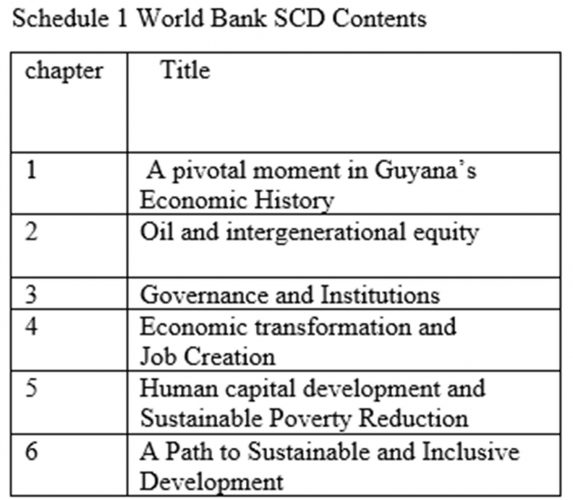Part 1
Introduction
As revealed in this column series thus far, in early 2020, extractivist and neoextractivist-oriented interpretations of the series of prolific oil reservoirs discovered offshore Guyana have already yielded the transformative notion of Guyana as a rapidly emerging Petrostate. The vigilance exhibited in this analytical adaptation has been by any measure striking.
I believe this notable achievement has been matched in an equally speedy recognition of Guyana’s potential for transformation in neoliberal schools of thought and policy prescription. I offer as evidence of this two works; namely, the IADB 2020 study [Traversing a Slippery Slope, Guyana’s Oil Opportunity] and the World Bank staff’s 2020 work [A Pivotal Moment, Guyana’s Oil Opportunity, Systematic Country Diagnostic] as examples. I have already reviewed the IADB work at some length during 2020 and 2021. Today I start a review of the World Bank work.
World Bank’s SCD
In its publication of Guyana’s SCD, the World Bank states clearly that its work is a product of its Staff. Consequently, its “findings, interpretations, and conclusions… do not necessarily reflect the views of the World Bank, its Board of Executive Directors, or the governments they represent”. This assertion enhances the profile of SCDs as being intellectually independent and driven by pure reason and analysis. In other words, they are not standard World Bank offerings.
Additionally, on its Website the World Bank offers visitors what it asserts is the kernel of any nation’s SCD. It poses the problematic as 1] Establishing: What are the main issues or matters for maximizing sustainable poverty reduction and welfare improvements or shared prosperity in a nation. This is accompanied with four questions; namely; a] What are the nation’s measures for poverty, shared prosperity and sustainability b] What are the critical drivers and constraints on economic growth c] What are the critical determinants of growth inclusivity [that is, increased welfare for the poor] d] How sustainable, [economically, environmentally and fiscally] are these dynamics.
Prefatory Statement
The brief prefatory statement to the Guyana SCD makes three important observations. First, it dramatizes the opportunities for Guyana going forward. Thus, it bluntly asserts: ‘Guyana stands at the threshold of a new era. The recent discovery of vast offshore oil and gas (O&G) reserves and the start of production, is poised to fundamentally transform the structure of the Guyanese economy while generating an influx of fiscal revenue”.
It has acknowledged that 1] before the oil finds starting in 2015, extractive industries and commodity exports were already playing a major role in Guyana’s economy and public finances 2] the mining sector however, created relatively few jobs and had a limited impact on poverty reduction.
In such a societal context, the expansion of the oil and gas sector will pose quite serious macro-fiscal management challenges even as it simultaneously offers new opportunities to address, what the SCD terms as “longstanding development constraints”.
Second, it recognized that the country was facing the COVID-19 pandemic challenges in 2020. These challenges will not only stretch the public health systems but highlight its basic inadequacies in key areas like testing and treatment facilities.
Third, the SCD is organized into six chapters as captured in Schedule 1 below
Source World Bank 2020
Chapter 1 situates the development of the oil sector within Guyana’s broader economic, social, and political context.
Chapter 2 estimates the magnitude of fiscal revenues from the oil sector, along with alternative cost scenarios, and the implications of alternative strategies for allocating these revenues and considers how policies can mitigate the macro-fiscal and environmental risks posed by the sector.
Chapter 3 focuses on institutional quality and good governance, especially in terms of strengthening the public sector, and it details challenges related to the design and implementation of a sovereign wealth fund, which the international experience has shown to be vital to the success of resource-rich developing countries.
Chapter 4 explores how the government can leverage natural resource revenues to accelerate Guyana’s economic transformation and spur job creation.
Chapter 5 evaluates strategies for transforming Guyana’s natural capital into human capital and reaching full coverage of basic services and infrastructure through investment in health, education, and social protection. The chapter highlights the constraints in human capital development and health facilities; even more critical that these are addressed in context of the current COVID-19 pandemic.
Chapter 6 prioritizes interventions necessary to generate enduring gains in poverty reduction and shared prosperity. A key offering of the chapter is a spatial development package to address deficiencies in basic service delivery and infrastructure necessary to protect well-being and health of Guyanese citizens.
To ground the analysis in the real-world experience of Guyanese communities, each chapter begins with a brief discussion of how the newfound wealth will affect the most vulnerable and marginalized households.
Conclusion
Next week I report on the individual Chapters in the World Bank Guyana SCD 2020. For reader’s benefit it should be noted that World Bank SCDs were first prepared in 2014, with Guyana’s 2020 its first and only.







